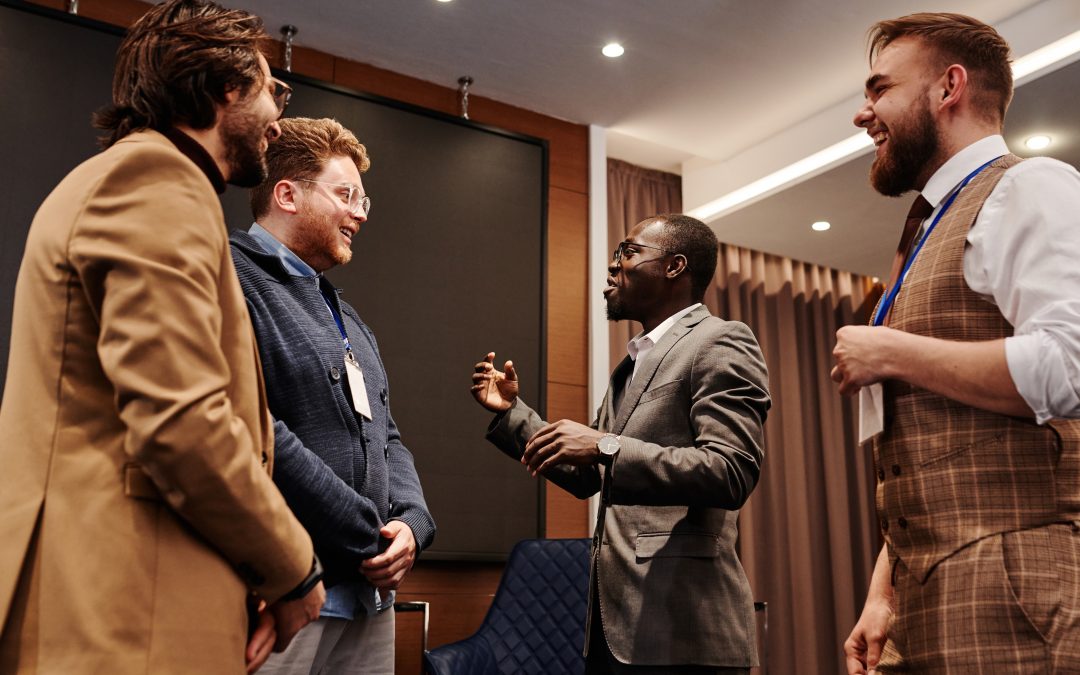 Why do we introduce ourselves?
Why do we introduce ourselves?
We want people to know how to address us. We want to share a bit of information about who we are and what we do so there is a point of connection. We want people to remember us and something about us.
Many reasons and many contexts. What we say – the content – and how we say it – the delivery – will vary but there are basic considerations across the board.
I would say that any introduction is a doorway inviting connection. As the speaker, I want the listener to, first, understand and take in what I say, and second, take an interest in something I say, hopefully leading to more communication, either immediately or down the road.
Let’s look at these two areas – delivery and content.
DELIVERY
Speaking clearly, making sure you are heard, and being welcoming – these are all important in an effective introduction. And yet, it is surprising how often people rush through a prepared introduction with all the content recommended for an “elevator speech”, within the time restrictions for the event, but the listeners can’t take anything in. Why is this?
1. Slow down – Many people get nervous introducing themselves in a formal setting and, even informally, they are often unsure as to what to say. Making sure to slow down, pause and clarify any unusual vocabulary is key. This is especially important if your name is uncommon, your company is relatively unknown, or you are sharing technical or business-oriented information. Clarify or repeat unusual vocabulary or just don’t use it.
We commonly use first names in Canada, so here’s an example of how I might introduce my name: “My name is Heather, (pause and slowly) Heather Chetwynd.”
Most people will not remember an uncommon last name. And even though my first name is common in English, it isn’t in other languages. If your first name is not common, this repetition of the first name helps me remember. When speaking with non-native speakers, I will often add with a smile: “Heather, like feather, weather and leather.”
This doesn’t take long but goes a long way to helping people remember your name.
2. Project your voice – Projecting does not mean yelling. It is using your voice with a foundation, greater resonance, coming from your body instead of just your head. This is especially important when talking to a group of people. I generally suggest imagining you are speaking to the person furthest from you. The mental adjustment is usually followed by a natural physical adjustment, creating a stronger, more effective voice.
3. Connect with your eyes and smile – Look at your audience, whether one-on-one or around a business table. Make eye contact with several people around the table or with the individual you are addressing. And remember to smile.
In Canada, even in formal situations, it is important to smile now and then at least – it relaxes the listeners and shows them you are friendly. I like to think that the Canadian smile is equivalent to a dog that raises its tail – a sign that I am friend, not enemy – straight-forward and simple body language. I know some people think all this smiling is just fake, put on, not honest. But for people born and raised here, it is a simple polite convention that is important to attend to.
CONTENT
With appropriate delivery, the content you express will affect how wide you are opening the communication door and how easy it is for people to enter. If you are at a party, you may simply say your first name and leave it at that. But if you are not already engaged in a conversation, you will need to say something for the other person to grab on to somehow. If you are at an event, it is likely already clear what general content is to be shared.
Some key things to consider regarding what you say:
1. Don’t ramble – Be prepared to introduce yourself. Explore what could be of common interest. At a party, perhaps you have a comment or question to ask the other person after sharing your name. Choose something that could be a point of connection. For example:
“Hi, I’m Heather. I’m an old friend of x. Nice to meet you. How are you connected to the host?”
At a networking event, share your name, company, area of expertise and relevant key points that make you unique. For example:
“Hello everyone, my name is Heather, H e a t h e r C h e t w y n d. I am the founder and director of V o i c e to W o r d C o n s u l t i n g. Our clients are working professionals who want to refine their English communication skills. They are fluent yet have gaps in their English knowledge and skills. We work one-on-one with them to refine their skills – to speak more clearly, more effectively, more correctly.”
2. Include an invitation – In the example I gave of an introduction at a party, the call to action is the question, an invitation to continue the communication. This is always important, sharing with the audience how to enter the communication door.
The second example I gave – the introduction at a networking event – has no invitation, no call to action. Let’s look at what can be said in different contexts:
Networking event: “I’m very interested in making connections with people responsible for Learning and Development – HR or managers – and I would love to exchange details about what you and I both work at to see how we might collaborate or support each other in future.”
Business meeting: “I’m happy to meet you all and would love to get some time to chat individually after the meeting. Please reach out and I will too.”
Group introduction at a social event: “I’m really happy I came, looking forward to the event and hoping some of us get the chance to chat at some point over the night.”
Remember that an introduction is an invitation to communicate, an opening to connection. If you keep this in the forefront of your mind – this generosity vs self-consciousness – people will be drawn to you naturally. Your intention will dominate.

